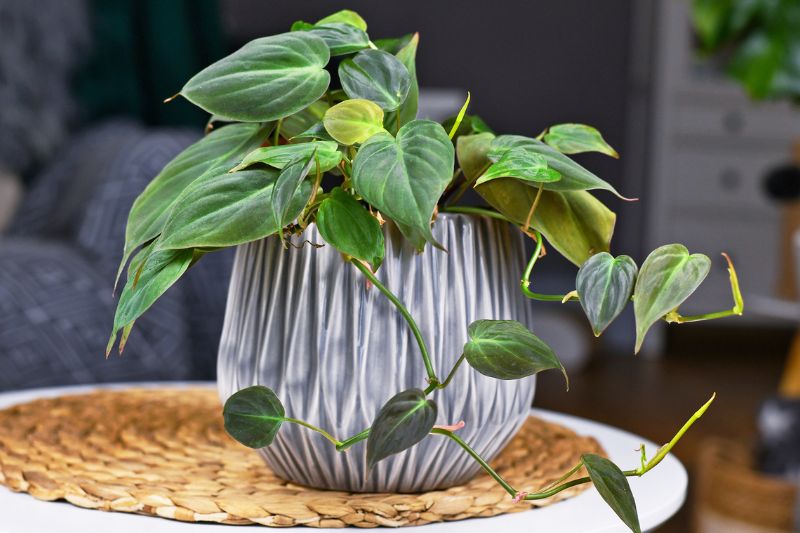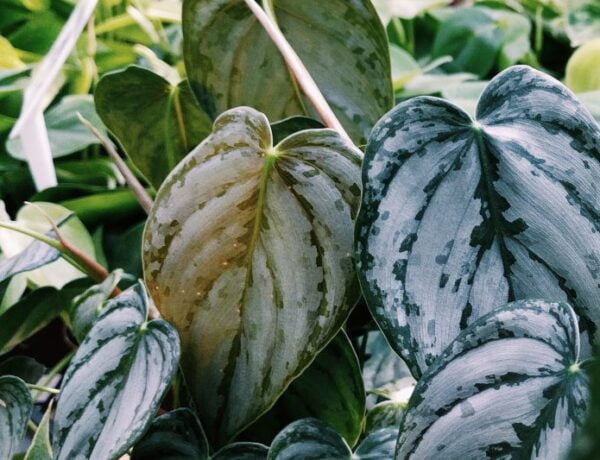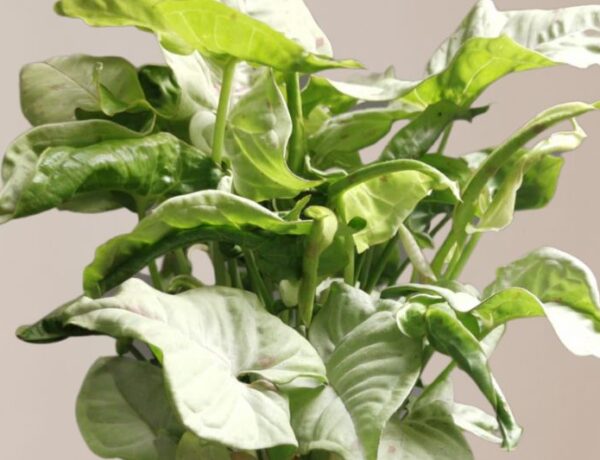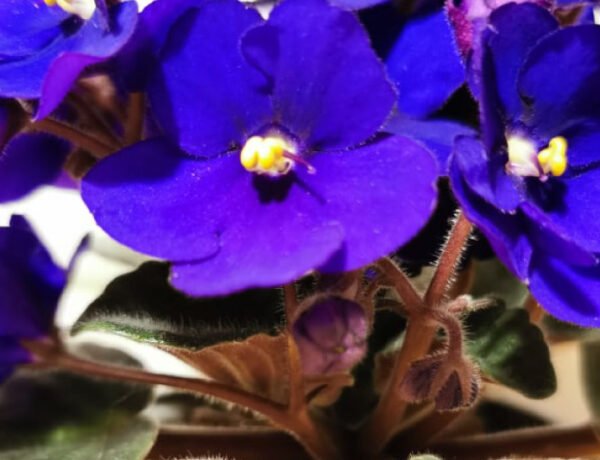Philodendron micans, under his scientific name Philodendron hederaceum var. hederaceum, is an appealing houseplant that is relatively easy to care for. It comes with a lovely palette of colors and a unique velvety texture that makes it a cute addition to any indoor garden.
Known for its heart-shaped leaves that shimmer in hues of bronze, purple, and deep green, this plant is also loved for its hardiness and straightforward care requirements.
Now, let’s see what it takes to care for this philodendron variety!
Table of Contents
1. Taxonomy & General Information
| Scientific name: | Philodendron hederaceum var. hederaceum |
| Common names: | Philodendron hederaceum, Velvet-leaf Philodendron, Philodendron Micans |
| Native to: | the rainforests of Central America and the Caribbean |
| Toxicity: | Philodendron micans contains calcium oxalate crystals, making it toxic to humans and pets if ingested |
| Growth Rate: | Moderate to fast under optimal conditions |
| Category: | Vining and climbing houseplant |
| Dormancy Period: | Winter |
| Flowering Season: | Spring, but rarely flowers indoors |
| Mature size: | Vines can reach lengths of up to 20 feet under ideal conditions. |

2. Philodendron Micans Care & Growing Requirements
» Watering
Philodendron micans loves a good drink, but it’s sensitive to overwatering. The trick is to wait until the top 2-3 inches of the soil have dried out before watering again.
Look out for signs that the plant needs hydration – the leaves will begin to droop and curl inward slightly. Always make sure the plant has good drainage, as philodendrons do not appreciate having their roots sit in water.
» Light
Philodendron micans enjoys bright to medium indirect light, perfect for an east or north-facing window. Too much direct sunlight should be avoided as it can burn its leaves, leading to yellowing or browning.
Fun fact, the light exposure directly influences the color of the leaves – increased light can cause the leaves to develop a red/maroon hue, while less light results in deeper green leaves.
» Soil
This plant prefers a soil mix that mimics its natural, tropical environment – light, airy, moist, and rich in organic matter. A well-draining soil mix is essential to prevent waterlogging and root rot.
A blend of 1 part potting soil, 1 part orchid bark, 1 part perlite, and 1 part peat moss or coco coir makes for an ideal soil mixture for Philodendron micans. You can also add a layer of worm castings to make sure your plant received the nutrients it needs to thrive.
» Temperature
As a plant with tropical origins, this one enjoys warmth. Keep your Philodendron micans at typical household temperatures (between 65°F and 80°F). It’s also important to protect it from cold, drafty windows or air vents which can damage the foliage and slow down growth.
» Humidity
While it can tolerate average household humidity levels, providing extra humidity, such as placing it near a humidifier or on a pebble tray with water, can help your Philodendron micans flourish.
» Fertilizer
Even though Philodendron micans can thrive in a soil rich in organic matter without additional fertilizer, supplying a light, balanced all-purpose fertilizer during its active growing period in spring and summer can support healthier growth and richer foliage color.
3. Philodendron Micans Maintenance and Propagation
» Repotting
Like all houseplants, Philodendron micans needs to be repotted once it outgrows its current pot. This typically happens every 2-3 years. Look for signs like roots growing out of the drainage holes or the plant becoming top-heavy.
When repotting, choose a pot that’s about 2 inches larger in diameter than the current one and ensure it has good drainage. Use the recommended soil mix for the best results.
» Pruning
Pruning is usually done to keep your Philodendron micans in check and maintaining its lush, full appearance. Regular pruning, particularly during the active growing period in spring and summer, can prevent your plant from becoming leggy.
Use sterilized pruning shears to snip any stems that are particularly long or unhealthy. Pruning not only improves the look of your plant but also encourages more vigorous and bushy growth.
» Propagation
Philodendron micans can be easily propagated, which means you can multiply your plant collection without spending a dime! To do so, take stem cuttings from a healthy plant, ensuring each cutting has about 4-5 leaves.
Remove the bottom two leaves to expose the nodes along the stem, then place the stem cuttings in water, in a location that receives medium to bright indirect light. After a few weeks, roots should begin to develop. Once the roots are about an inch long, the cuttings can be transferred into soil.
4. Common Issues
While the Philodendron micans is generally an easy-going plant, certain common issues can occur if its care needs aren’t met.
» Yellowing Leaves
This is often a sign of overwatering. If the leaves of your Philodendron micans start to yellow, check the moisture levels in the soil. It’s important to let the top 2-3 inches of the soil dry out before watering again. Overwatering can lead to waterlogged soil, causing the roots to suffocate and ultimately leading to root rot.
» Leggy Growth
If your Philodendron micans begins to look sparse or leggy, it may not be receiving enough light. This plant loves bright, indirect light. Too little light can cause the plant to stretch towards the light source, resulting in long, leggy stems with few leaves. If this happens, gradually move your plant to a location with more light.
» Small Leaves
If you notice the new leaves on your Philodendron micans are smaller than usual, it may be a sign of insufficient nutrients or light. The plant may need a nutrient boost from a well-balanced fertilizer. Additionally, ensure the plant is getting enough indirect light, as lack of light can stunt leaf growth.
» Drooping Leaves
Although the Philodendron micans leaves slightly droop when thirsty, excessive drooping could be a sign of too much water or not enough light. Check the soil to see if it’s waterlogged and move the plant to a brighter location if necessary.
» Brown Leaf Tips
This could be due to low humidity or over-fertilization. As a tropical plant, Philodendron micans loves high humidity, so try to increase humidity levels if you notice browning leaf tips. If you’ve been heavy-handed with fertilizer, try flushing the soil with water to remove excess salts.
5. Diseases and pests
Although Philodendron micans is generally hardy, it’s not immune to diseases and pests. Overwatering can lead to root rot, a common disease for houseplants, while poor air circulation can lead to fungal leaf spots. Regularly inspect your plant for common pests, including aphids, mealybugs, and spider mites.
Good plant hygiene (like wiping leaves and avoiding waterlogged soil) can go a long way in preventing these issues.
6. Conclusion
With its lush foliage and easy care, the Philodendron micans is a wonderful addition to any houseplant collection. Its ability to adapt to various indoor environments makes it a favorite among both novice and experienced gardeners.
By providing the right care and promptly addressing any issues, you can enjoy the beauty of this tropical plant year-round. Also, if you’re interested in more philodendron varieties similar to this one, make sure to check our care guide on its cousin, Heartleaf Philodendron!






No Comments